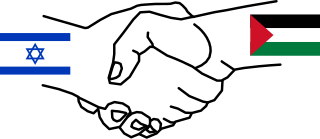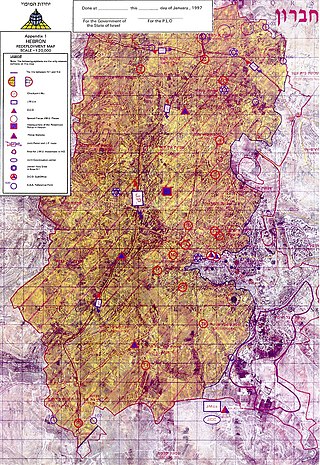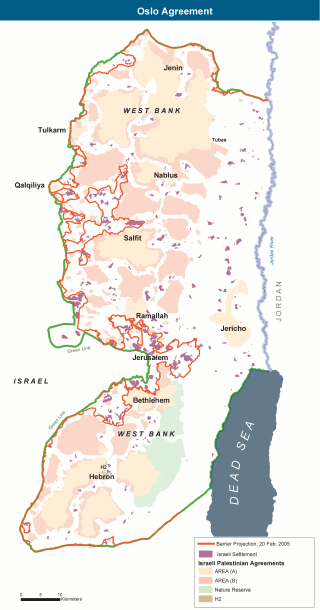The Protocol on Environmental Protection to the Antarctic Treaty, also known as the Madrid Protocol, is a complementary legal instrument to the Antarctic Treaty signed in Madrid on 4 October 1991. It entered into force on 14 January 1998.

The Oslo I Accord or Oslo I, officially called the Declaration of Principles on Interim Self-Government Arrangements or short Declaration of Principles (DOP), was an attempt in 1993 to set up a framework that would lead to the resolution of the ongoing Israeli–Palestinian conflict. It was the first face-to-face agreement between the government of Israel and the Palestine Liberation Organization (PLO).

The Interim Agreement on the West Bank and the Gaza Strip commonly known as Oslo II or Oslo 2, was a key and complex agreement in the Israeli–Palestinian peace process. Because it was signed in Taba, Egypt, it is sometimes called the Taba Agreement. The Oslo Accords envisioned the establishment of a Palestinian interim self-government in the Palestinian territories. Oslo II created the Areas A, B and C in the West Bank. The Palestinian Authority was given some limited powers and responsibilities in the Areas A and B and a prospect of negotiations on a final settlement based on Security Council Resolutions 242 and 338. The Accord was officially signed on 28 September 1995.

The Geneva Initiative, also known as the Geneva Accord, is a draft Permanent Status Agreement to end the Israeli–Palestinian conflict, based on previous official negotiations, international resolutions, the Quartet Roadmap, the Clinton Parameters, and the Arab Peace Initiative. The document was finished on 12 October 2003.

The Wye River Memorandum was an agreement negotiated between Israel and the Palestinian Authority at a summit in Wye River, Maryland, U.S., held 15–23 October 1998. The Memorandum aimed to resume the implementation of the 1995 Interim Agreement on the West Bank and the Gaza Strip. It was signed in the White House by Benjamin Netanyahu and Yasser Arafat, through negotiations led by U.S. President Bill Clinton, on 23 October 1998. On 17 November 1998 Israel's 120-member parliament, the Knesset, approved the Memorandum by a vote of 75–19. The Memorandum determined that it would enter into force on 2 November 1998, ten days from the date of signature.

The Protocol Concerning the Redeployment in Hebron, also known as the Hebron Protocol or Hebron Agreement, was signed on 17 January 1997 by Israel, represented by Prime Minister of Israel Benjamin Netanyahu, and the Palestine Liberation Organization (PLO), represented by PLO Chairman Yasser Arafat, under the supervision of U.S. Secretary of State, Warren Christopher. It concerned the partial redeployment of Israeli military forces from Hebron in accordance with the 1995 Interim Agreement on the West Bank and the Gaza Strip. According to the Protocol, Area H-1 would come under Palestinian control, while Area H-2 would remain under Israeli control. A large Palestinian majority still lives in both Area H-1 and Area H-2. The redeployment started on 16 January 1997. The protocol has never been ratified by either of the contracting parties.
The Gaza–Jericho Agreement, officially called Agreement on the Gaza Strip and the Jericho Area, was a follow-up treaty to the Oslo I Accord in which details of Palestinian autonomy were concluded. The agreement is commonly known as the 1994 Cairo Agreement. It was signed on 4 May 1994 by Yasser Arafat and the then Israeli Prime Minister Yitzhak Rabin.

The Oslo II Accord divided the Israeli-occupied West Bank into three administrative divisions: the Palestinian enclaves as "Areas A and B" and the remainder, including Israeli settlements, as "Area C".
The water resources of Palestine are de facto fully controlled by Israel, and the division of groundwater is subject to provisions in the Oslo II Accord.
The Protocol on Economic Relations, also called the Paris Protocol, was an agreement between Israel and the PLO, signed on 29 April 1994, and incorporated with minor amendments into the Oslo II Accord of September 1995.
Water conflict in the Middle East and North Africa (MENA) primarily deals with three major river basins: the Jordan River Basin, the Tigris-Euphrates River Basin, and the Nile River Basin. The MENA region covers roughly 11.1 million square km. There are three major deserts in the MENA region:

The Oslo Accords are a pair of interim agreements between Israel and the Palestine Liberation Organization (PLO): the Oslo I Accord, signed in Washington, D.C., in 1993; and the Oslo II Accord, signed in Taba, Egypt, in 1995. They marked the start of the Oslo process, a peace process aimed at achieving a peace treaty based on Resolution 242 and Resolution 338 of the United Nations Security Council. The Oslo process began after secret negotiations in Oslo, Norway, resulting in both the recognition of Israel by the PLO and the recognition by Israel of the PLO as the representative of the Palestinian people and as a partner in bilateral negotiations.

The Palestinian Legislative Council (PLC) is the unicameral legislature of the Palestinian Authority, elected by the Palestinian residents of the Palestinian territories of the West Bank and Gaza Strip. It currently comprises 132 members, elected from 16 electoral districts of the Palestinian Authority. The PLC has a quorum requirement of two-thirds, and since 2006 Hamas and Hamas-affiliated members have held 74 of the 132 seats in the PLC. The PLC's activities were suspended in 2007 and remained so as of November 2023, while PLC committees continue working at a low rate and parliamentary panel discussions are still occurring.
The Israeli–Palestinian Joint Water Committee (JWC) is a joint Israeli–Palestinian authority, created in 1995 by the Oslo II Accord. Its purpose is to manage water and sewage related infrastructure in the West Bank, particularly to take decisions on maintenance of existing infrastructure and approval of new projects. Although it was originally intended to be a temporary organ for a five years interim period, it still exists as of 2015.
The Environment Quality Authority, in Arabic: الهيئة العامة للبيئة, is the central authoritative body for all environmental issues in the Palestinian territories. It is the umbrella under which all environmental regulations, projects and strategies are created and implemented. MEnA's primary concern is the conservation and sound use of the natural environment. It seeks to maintain and safeguard the environment with plans to protect human health, curb and reduce the depletion of natural resources, combat desertification, prevent the aggravation of air and water pollution, promote environmental awareness and ensure achievement of sustainable urban development.
Gaza Seaport is a planned seaport in the Gaza Strip. The establishment of a Gaza seaport was mentioned in the Oslo I Accord, as early as 1993. The 1999 Sharm el-Sheikh Memorandum determined that the construction works could commence on 1 October 1999. The project started on 18 July 2000, but was stopped in an early stage due to obstruction of the supply of construction materials, and destruction by the Israeli army in September and October 2000 when the Second Intifada inflamed. The 2005 Agreement on Movement and Access, following Israel's withdrawal from Gaza, re-announced the start of the works. Israel promised to assure donors that it will not interfere with operation of the port. As of 2014, however, the construction has not been resumed.
Abu Dis is a Palestinian town in the Jerusalem Governorate of the Palestinian National Authority bordering Jerusalem. Since the 1995 Interim Agreement on the West Bank and the Gaza Strip, Abu Dis has been part of "Area B", under joint Israeli and Palestinian control. According to the Palestinian Central Bureau of Statistics (PCBS) census, Abu Dis had a population of 10,782 in 2007.

Israel–Palestine relations refers to the political, security, economical and other relations between the State of Israel and the State of Palestine. Israel and the PLO began to engage in the late 1980s and early 1990s in what became the Israeli–Palestinian peace process, culminated with the Oslo Accords in 1993. Shortly after, the Palestinian National Authority was established and during the next 6 years formed a network of economic and security connections with Israel, being referred to as a fully autonomous region with self-administration. In the year 2000, the relations severely deteriorated with the eruption of the Al-Aqsa Intifada – a rapid escalation of the Israeli–Palestinian conflict. The events calmed down in 2005, with reconciliation and cease fire. The situation became more complicated with the split of the Palestinian Authority in 2007, the violent split of Fatah and Hamas factions, and Hamas' takeover of the Gaza Strip. The Hamas takeover resulted in a complete rift between Israel and the Palestinian faction in the Gaza Strip, cancelling all relations except limited humanitarian supply.

The Palestinian Security Services (PSS) are the armed forces and intelligence agencies of the State of Palestine. They comprise twelve branches, notably the Security Forces, the civil police, the Presidential Guard and the national security forces. The President of the Palestinian National Authority is Commander-in-Chief of the Palestinian Forces.

The Palestinian Naval Police, also known as the Gaza Marine, is a branch of the Palestinian National Security Forces whose task includes securing the coastline of the Gaza Strip. The Naval Police was established in the Gaza–Jericho Agreement signed on 4 May 1994. Under the Oslo II Accord, its activities are restricted to 6 nautical miles from the coast.









